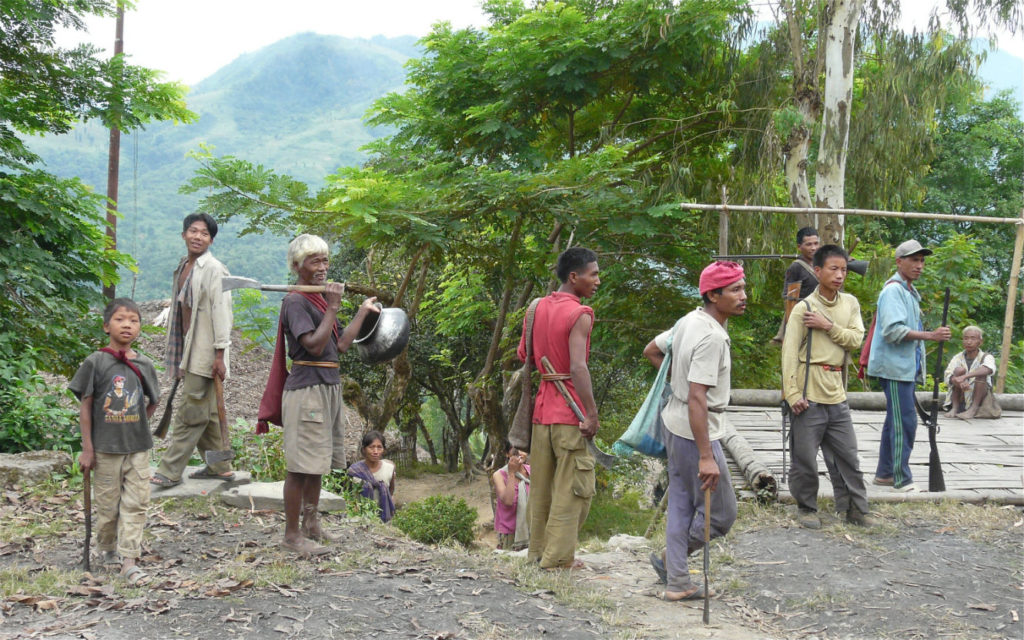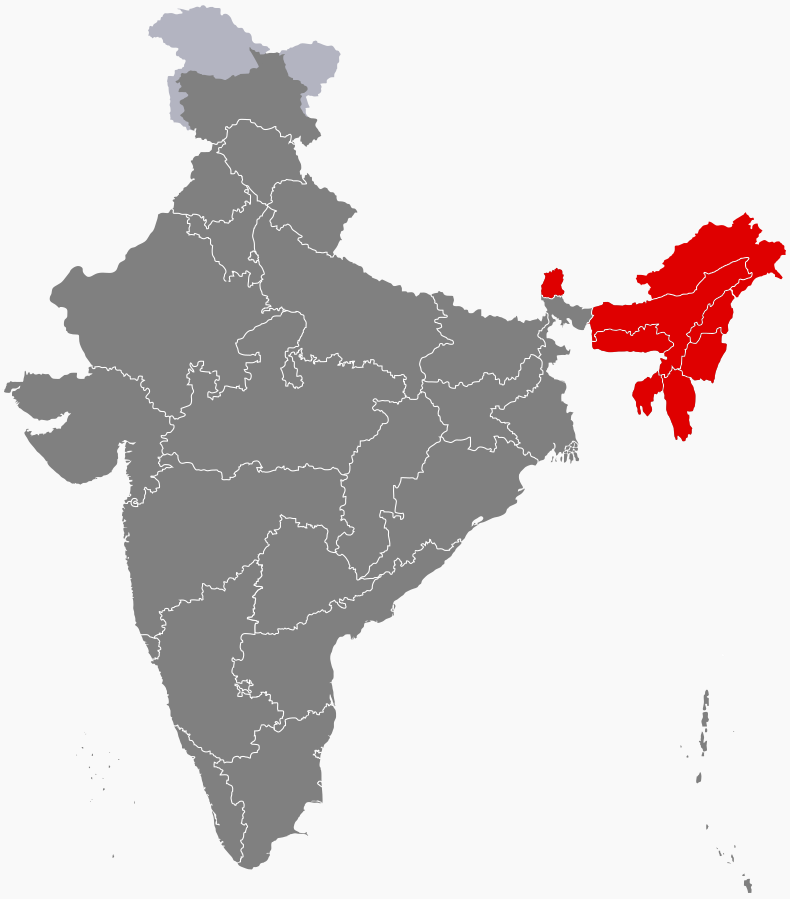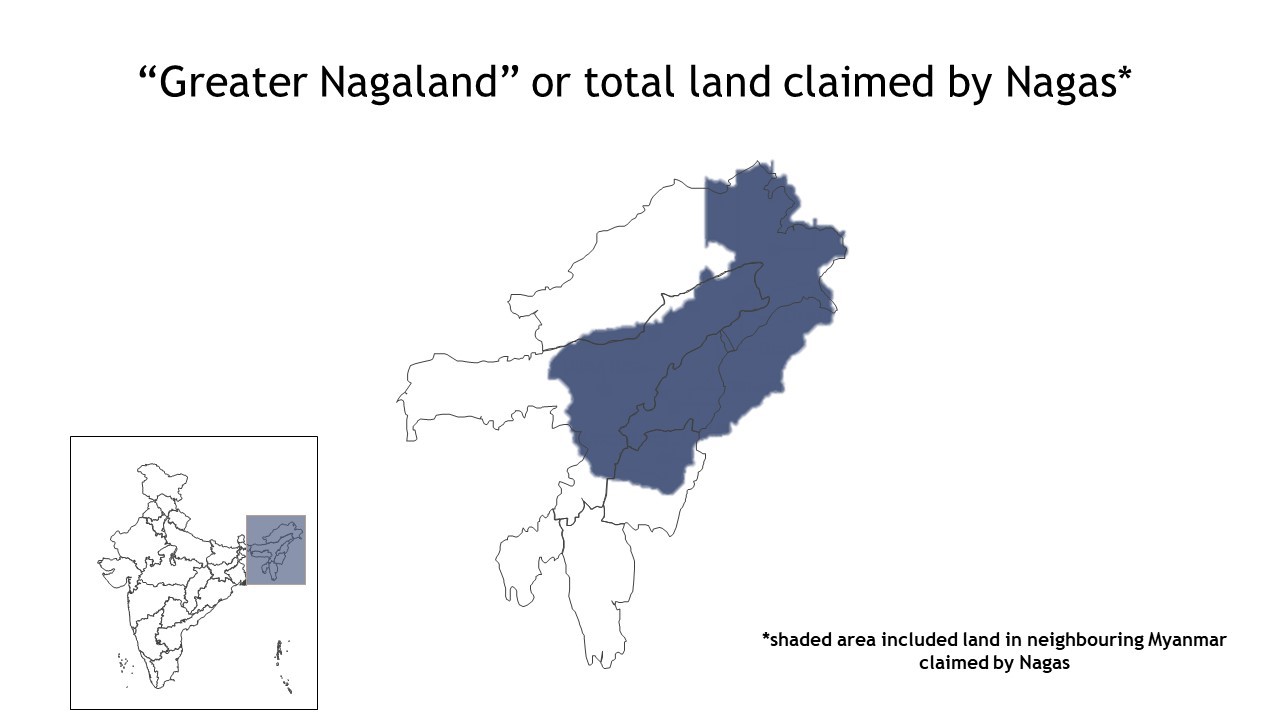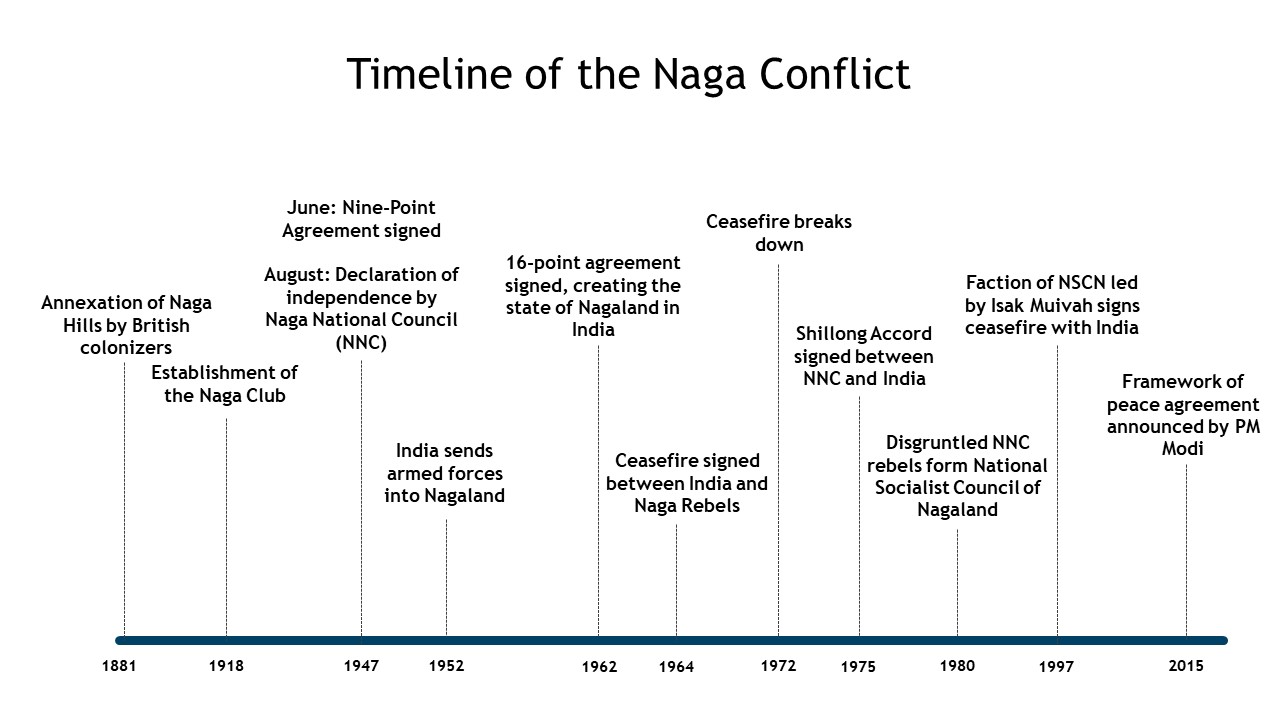Nagaland’s Time: A States-Led Effort to Resolve the Naga Conflict

On Aug. 3, 2015, news broke that the government of India and the largest Naga rebel organization, the National Socialist Council of Nagaland – Isak-Muivah (NSCN-IM), had reached an agreement on the framework for a peace accord.
One of us — Kartikeya Singh — has a personal connection to the conflict. His grandfather received national recognition for his efforts as a senior official from India’s Border Security Force to facilitate a major peace accord with Naga rebel factions in 1975. It took another 33 years to forge an agreement with the NSCN-IM, which speaks to the complexities of the Nagaland dispute, one of the world’s “oldest unresolved armed conflicts.”
Since 1952, Naga rebels in northeastern India have engaged in a violent insurgency against the government of India, fighting for a separate “Nagalim” or “Great Nagaland” for all Naga people. The August 2015 announcement offered a ray of hope — not just for bringing peace to Nagaland, but for resolving the last vestiges of a conflict that has limited development in several Indian states and hindered India’s ambitions as it looks to “Act East.” Nearly four years later, the road to a lasting peace remains challenging.
Because of the conflict’s geostrategic location on India’s land border with Southeast Asia and the way it has hindered infrastructure development in the region, resolving the Nagaland issue can unlock new development opportunities and catalyze a new era of trade, infrastructure, and cultural connectivity with Southeast Asia, thereby reenergizing the “Act East” policy. We recommend a two-step approach to move towards resolution once the disparate Naga rebel factions have united: First, repealing the Armed Forces (Special Powers) Act in Nagaland and nearby Manipur; and second, a states-led resolution process that allows for the creation of a virtual state that protects and administers the cultural and land rights practices of the Naga. Such an approach would be palatable to all parties and bolster the Naga identity within the union of India without compromising the existing territorial integrity of any state.
Background and Efforts at Peace
Today, India’s northeast, a patchwork of mountains, forests, and lush plains, is isolated from the mainland by the 22 kilometer-wide Siliguri corridor that connects the state of West Bengal to Assam. Prior to India’s independence and the creation of present-day Bangladesh, the region was at the margins of the British Indian Empire, and the tribes nestled in it were treated more distinctly by the British than other regions on the subcontinent. The British cared less about the relatively small populations in the region and their governance than they did about having access to land and the movement of goods and resources between eastern India and present-day Burma.
The relatively isolated northeast has long been plagued with conflict. Of India’s “Seven Sisters,” or northeastern states, Mizoram, Manipur, Assam, Nagaland, and Tripura have experienced varying levels of violence since 1945. However, the conflict in Nagaland — known popularly as the “mother of insurgencies” — stands out.

Northeast India (Wikimedia Commons)
The conflict dates back to 1881, when British colonists annexed the Naga hills to control strategic trade routes in India’s northeast and into Burma (current-day Assam, Manipur, and Myanmar). By 1918, the seeds of Naga nationalism had taken root with the establishment of the Naga Club, which advocated against integrating the Nagalim with the rest of India. Toward the end of British rule, the new Indian government began negotiations with the Naga National Council, the successor to the Naga Club, and reached a Nine-Point Agreement in June 1947, which allowed the Nagas to “develop themselves according to their freely expressed wishes.”
However, a disagreement emerged about whether the deal could be extended, or a new one agreed upon, at the end of a 10-year period. This disagreement led to a Naga declaration of independence by Aug. 14, 1947, one day before India became independent. India responded in 1952 by sending its armed forces into Nagaland to reclaim the territory, beginning a violent insurgency.
Following the deployment of Indian forces, the violence exploded, and the insurgency could not be controlled. As such, then-President of India Rajendra Prasad enacted “The Armed Forces (Assam and Manipur) Special Powers Ordinance, 1958,” which was later subsumed into the Armed Forces (Special Powers) Act, 1958. The act grants the Indian Army powers to fire upon suspected militants and arrest suspects without a warrant in their quest to maintain status quo in “disturbed areas.”
The implementation of the act has led to numerous human rights violations and has been described as “anathema to most people in the region” and as “draconian” by civil society organizations. The Supreme Court of India, too, has noted the pernicious nature of the law’s “license to kill,” demanding details on 1,582 extrajudicial killings in Nagaland’s neighboring state, Manipur, between 2000 and 2012. While the number of extrajudicial killings in Nagaland is not known, the act has remained in force in Nagaland for 61 years. It was extended most recently on Dec. 31, 2018.
A lack of unity among Naga rebels has repeatedly hampered efforts to negotiate a lasting peace over the years. In the early 1960s, the All Tribes Naga People’s Conference approached India with a proposal to create a state of Nagaland within India. The proposal culminated in the 16-Point Agreement that created the Nagaland state and gave local bodies significant autonomy over governance. However, the agreement was not respected by most of the Naga rebels, who continued fighting for an independent Nagalim.
Another breakthrough occurred with the Shillong Accord of 1975, where a segment of the Naga National Council agreed to unconditionally accept the Constitution of India and relinquish arms. However, this accord, too, was rejected by a large swath of rebels. These rebels, led by Isak Chishi Swu, Thuingaleng Muivah, and S.S. Khaplang, broke away from to form the National Socialist Council of Nagaland (NSCN).
With this schism, the Naga National Council became a nonentity. However, the newly formed NSCN, too, faced problems as the three leaders disagreed on whether the group should engage in a dialogue with the Indian government. By 1988, that faction had itself split into two groups, the NSCN-IM, which favored talks with India and was led by Isak and Muivah, and the NSCN-K, which opposed talks and was led by Khaplang. The government began negotiating with the former, which remains the largest Naga rebel organization, reaching a ceasefire in July 1997. Since, then peace talks have been ongoing, largely focused on the major demands put forth by the NSCN-IM:
- India should recognize the “unique history” of the Nagas
- Repeal of the Armed Forces (Special Powers) Act in Nagaland
- All Naga areas should be territorially integrated
- Nagas should have their own constitution that would cover governance in the integrated “Nagalim.”
India, for its part, has demanded that any governance structure for the Naga rebels must be within the structure of the Constitution of India, and has been opposed to any territorial changes involving the states of Assam, Arunachal Pradesh, and Manipur, where there are significant Naga populations. An unspoken concern for India has also been the degree of unity among the Naga rebels and ensuring that any peace settlement will lead to peace and not be rejected by Nagas as in the past.
It is along these points of negotiation that the August 2015 Framework Agreement was signed between the government of India and the NSCN-IM. Under the framework agreement, the Indian government has already fulfilled the first demand, with the prime minister’s office saying, “The Government of India recognized the unique history, culture and position of the Nagas and their sentiments and aspirations.” However, the continued application of the Armed Forces (Special Powers) Act and the demand for territorial integrity remain the most intractable. Today, the NSCN-IM and the government of India remain engaged in talks on a final peace agreement.
Moreover, segments of the Naga rebels continue to oppose peace talks. Indeed, Khaplang’s faction opposed the negotiations between the NSCN-IM and the government and has continued to engage in violence. On June 4, 2015, the group attacked an Army convoy in Manipur, killing 18. This attack resulted in the government of India declaring the faction “as a terrorist organization under the Unlawful Activities (prevention) Act, 1967.” The NSCN-IM all announced that they “considered [Khaplang] unrepresentative of the Naga people and their aspirations.”
Implications for Indian Foreign Policy
With India gearing up for the next central government elections in 2019, the prime minister’s bold announcement in 2015 needs to deliver on its promises. Resolving the conflict will unlock tremendous economic opportunities for the people living in India’s northeastern states and help fulfill India’s vision of its “Act East Policy,” which remains stymied.
“Act East,” which calls for deepened engagement with Southeast Asia, is a centerpiece of Prime Minister Narendra Modi’s foreign policy. The policy builds upon the “Look East Policy” crafted by Prime Minister P.V. Narasimha Rao, and has called for greater regional connectivity and land-based infrastructure from India toward Myanmar, Thailand, and countries further east. However, the implementation of this policy has remained stymied by the lack of resolution on the Naga conflict.
A recent example of how the Naga conflict has negatively impacted “Act East” is the United Naga Council’s blockade of National Highway 2, a part of Asian Highway 1, the long route of the Asian Highway Network. The blockade “restricted the flow of most commodities, raising the price of fuel to $4.50 a liter.” Moreover, as they were enforcing the blockade in 2017, the NSCN-IM attacked a supply convoy along a segment of National Highway 37, which is part of the broader Bangladesh-China-India-Myanmar project. The Jiribam-Tamu link of the Trans-Asian railway, too, saw stoppages in work due to the blockade.
The Path Forward
The first step to making tangible progress is for the government of India to repeal the Armed Forces (Special Powers) Act. While this suggestion is not new, it is a major obstacle to any political settlement with the Naga rebels. Providing this concession to the Naga would go a long way in building trust in the peace process.
The data also show that India no longer needs the controversial law. Violence in the region has already fallen considerably, with civilian deaths falling 83 percent and armed forces deaths decreasing by 40 percent. In addition, repealing the Armed Forces (Special Powers) Act will not only create renewed momentum for a peace settlement, but may also unite the fractious Naga groups, including the NSCN-K, at one negotiating table by taking away one of its chief complaints against India’s behavior.
This bold move will be considered contentious amongst the security establishment of the government of India, particularly as it is one of the key tools the military has used against insurgencies throughout the region. The military is also likely to argue that repeal would risk public safety, as violence could increase. However, the government can point to the successes following the repeal of the law in other northeastern states, such as Tripura in May 2015 and Assam, Meghalaya, and parts of Arunachal Pradesh in April 2018. In those states, like in Nagaland, the security environment had improved significantly, and the repeal of the law improved India’s goodwill without compromising public safety.
Repealing the Armed Forces (Special Powers) Act can also soften the ground for tackling the other contentious part of the Nagas’ territorial claims: the creation of a greater Nagalim, which could affect the peoples of several neighboring states. One promising theory that we have discussed with regional and conflict resolution experts puts the fate of this conflict in the hands of those living in the northeast when the conditions to negotiate a new agreement are ripe. This approach requires a dialogue between the state governments of the northeast and representatives of the Naga.
The government of India, particularly the Modi administration, which has been operating the nation under a cooperative federalism model, will likely accept whatever arrangements the states arrive at themselves as long as they stay within the union of India. As mentioned above, for India, maintaining its territorial integrity as a nation state is paramount, but the central government has been open in the recent past to the reorganization and creation of new states within the republic. Examples of this openness include the creation of the states of Uttarakhand, Chhattisgarh, and Jharkhand in 2000 and the bifurcation of Andhra Pradesh into Telangana and Andhra Pradesh in 2014.
The same theory also suggests the creation of a virtual state for the Nagas beyond the territorial bounds of Nagaland state. This proposal builds on existing models of separatist tribal conflicts from around the world. Colombia grants “a high degree of political and administrative autonomy to indigenous communities,” while in the Åland Islands, a predominantly Swedish-speaking population in Finland is granted cultural and political autonomy. India’s northeastern states can look to the structures and practices of these models to replicate this success.
One path forward could be the creation of a new institution headquartered in Nagaland that manages the land transfer and cultural issues for all the Naga across state boundaries without infringing on other states’ rights. This institution could be similar to the political institutions of Åland, where a government and Parliament guarantee the islands’ autonomy while ensuring representation in the Finnish Parliament.
Under such a model, the core demands and interests of the neighboring northeastern states would continue to be protected. The settlement would not include any transfer, exchange, or secession of any land from any of the states to the current state of Nagaland, nor would it involve any changes to constitutionally guaranteed powers granted to states regarding public administration.
Despite these constraints, both the NSCN-IM and NSCN-K would find such an agreement palatable. Short of a separate state, which remains out of the picture, the creation of such a “virtual state” beyond the territorial bounds of Nagaland state would see all four of the Nagas’ demands addressed. The demand for government recognition of the Nagas’ unique history has already been met — something an adviser to the Chief Minister of Nagaland described as “significant.” Any autonomous structure like that in Åland would build upon this progress, ensuring the third and fourth demands of cultural unity and separate governance of Nagas protected under the auspices of the broader Indian constitution.

Rather, the authority of the institution will extend the customary laws and cultural rights that the Indian constitution accords to those living in Nagaland to the Nagas in neighboring territories, along with special Naga courts. On the contentious issue of land, special clauses in the laws of neighboring states restricting regulations on Naga land transfer might further bolster the rights of the Nagas without needing to alter the boundaries of existing states.
Such a settlement would be a balanced compromise between the demands of the northeastern states and those of the Naga rebels. While the boundaries of the states and the constitutional powers of the states would not change, India can go a step further than recognizing and honoring the rights and history of the Naga people.
Nagaland and her neighbors are no longer a backwater of the British Empire, but a strategic region linking South and Southeast Asia. By making good on the promise to resolve the Naga conflict, the government of India and citizens of the northeast can unlock tremendous economic opportunities and create new types of governance structures to be modeled by other diverse nation states in the future.
Dr. Kartikeya Singh is the deputy director & fellow of the Wadhwani Chair in U.S.-India Policy Studies at the Center for Strategic & International Studies (CSIS). He leads the Chair’s “states initiative,” covering subnational regulatory and policy reform, and has shaped the center’s work on engagement with India’s states, particularly on energy and healthcare.
Aman Thakker is a research associate with the Wadhwani Chair in U.S.-India Policy Studies at the Center for Strategic and International Studies, where he leads the Chair’s projects on federal economic reforms and U.S.-India defense ties. He is also a contributor for The Diplomat, providing analysis on domestic politics, law, regulatory policy, and economics in India.
Image: Photo by Rita Willaert, CC BY-NC 2.0, via Flickr


